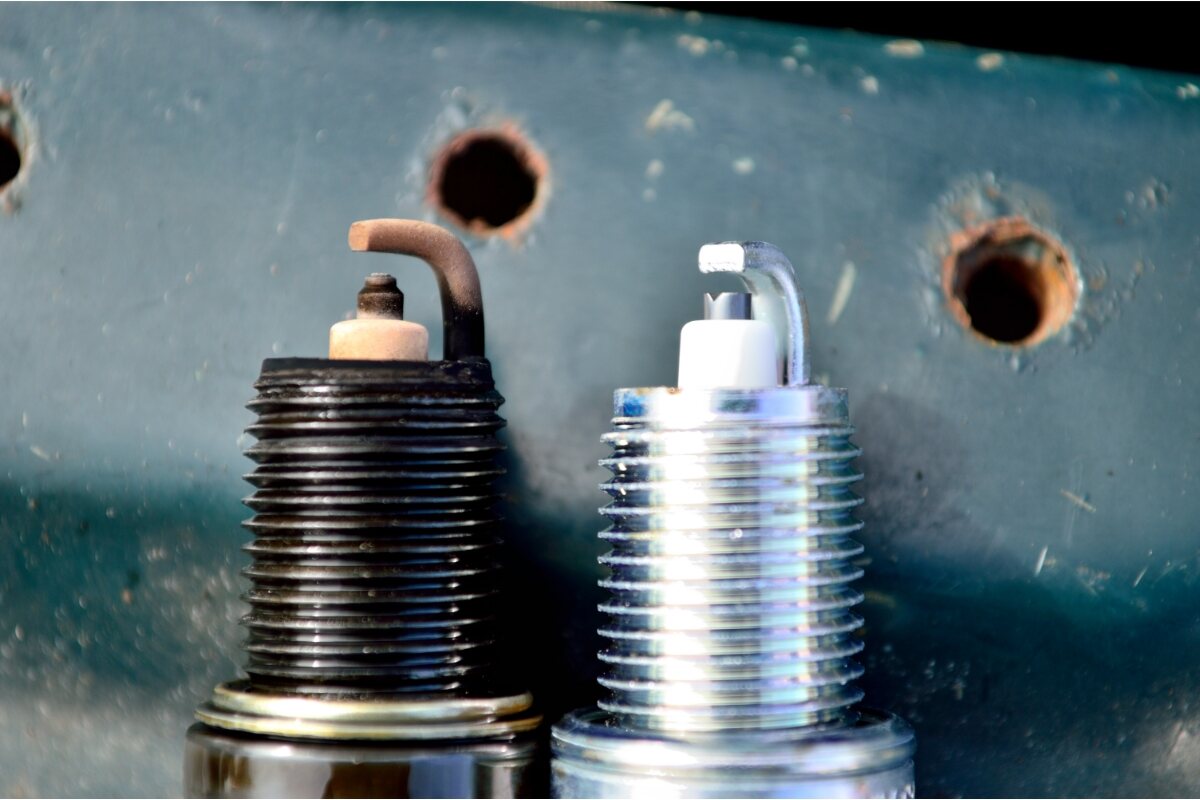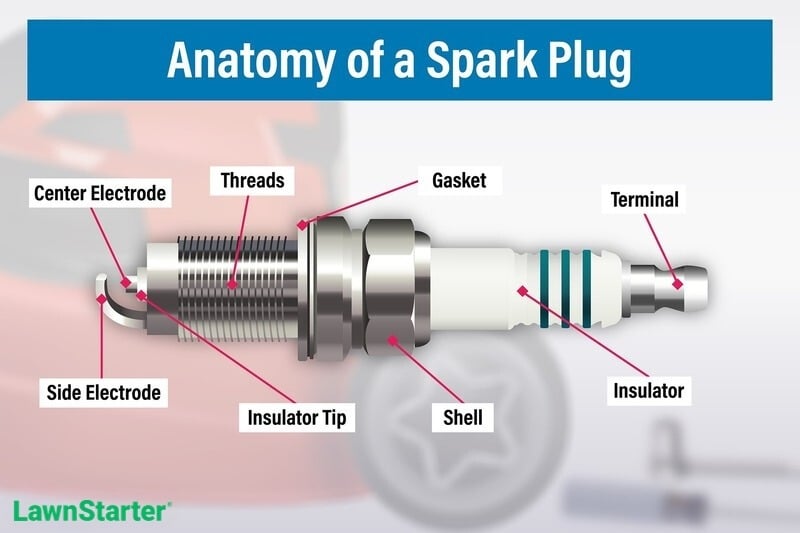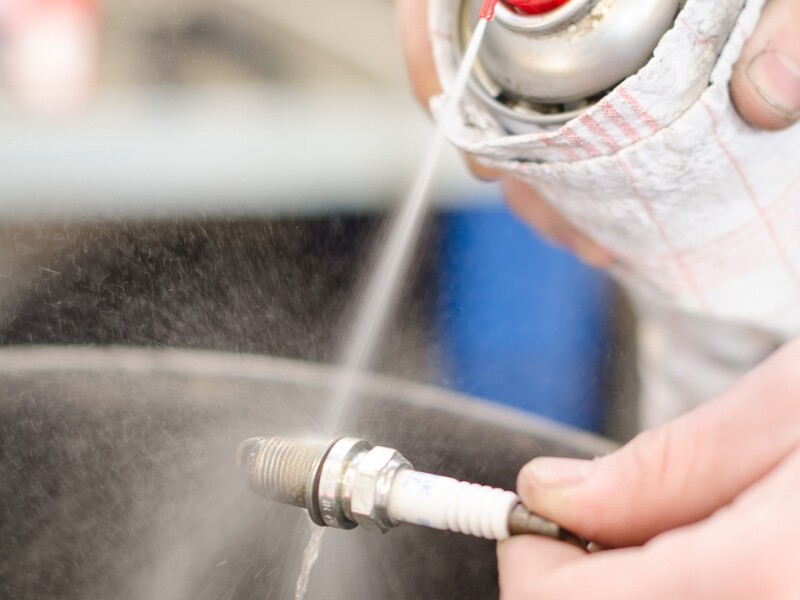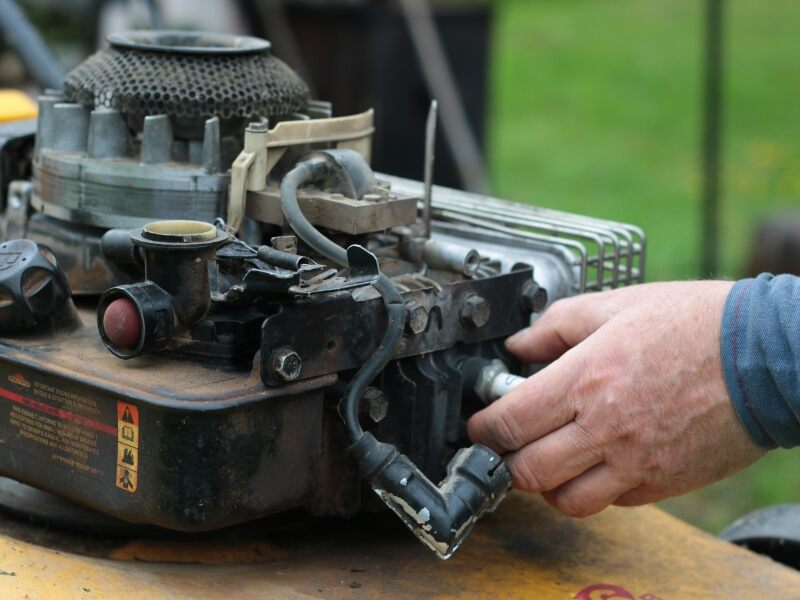
For lawn mowers with gas engines, checking the spark plug and replacing it if necessary is a fundamental part of regular maintenance. If you haven’t checked yours in a while, and your mower is having trouble starting, a new spark plug may be just what it needs. We’ll walk you through how to change spark plugs on your lawn mower DIY so you can get it up and running again in no time and with minimal cost.
How to Check and Change Spark Plugs on a Lawn Mower in 8 Steps
The first thing you’ll need to do is remove the old spark plug and find out if it needs to be replaced or just cleaned thoroughly. Then, you can move forward from there. The steps below will tell you how to check the spark plug for damage, how to clean it, and how to replace it if necessary.
See the spark plug diagram below to help guide you as you check and change your mower’s spark plug:

Step 1: Gather the Tools
Here is a simple list of the tools and materials needed to change spark plugs on a lawn mower:
- Spark plug socket
- Adjustable spark plug wrench
- New spark plug
- Spark plug gap tool
- Clean cloth
- Wire brush
- Safety gloves
- Safety goggles
- Drain pan
- Funnel
All these tools are affordable and easy to find online. Even the spark plug itself usually costs less than $10.
Step 2: Locate the Spark Plug
The spark plug is generally situated on the side of the lawn mower’s engine. Check the spark plug for a rubber or plastic-coated wire. Gently pull the wire boot (the rubber or plastic-coated part) away from the spark plug tip. It will allow you to see the spark plug for the next steps.
Step 3: Disconnect the Spark Plug Wire
After locating the spark plug, completely remove the spark plug wire. This ensures you do not start the engine while working on the spark plug. Grab the boot (rubber section) of the spark plug wire and pull it straight off the tip of the spark plug.
Step 4: Loosen and Remove the Old Spark Plug
It’s time to say goodbye to the old spark plug now that the spark plug wire has been detached. Turn the spark plug counter-clockwise with a spark plug socket wrench. Once free, unscrew the spark plug by hand until it’s entirely out of the engine.
If the plug is not ratcheting smoothly, apply a lubricant and let it sit for a few minutes. This will make it easier to remove the spark plug.
Step 5: Clean the Plug
After removing the old spark plug from the mower, inspect it for damage and heavy carbon buildup. Remove any loose dirt and grime from the exterior using a wire brush. If there is a lot of carbon buildup, soak the plug in a cleaning solution or gasoline for a few minutes. Before reinstalling, make sure the plug is thoroughly dry.
You can also use compressed air to clear away any remaining debris. Clean the electrode tip – the metal part that connects to the electrode and conducts electricity through the spark plug – carefully using a specialized spark plug cleaner or a wire brush.
Step 6: Check the Spark Plug Gap
Check the spark plug gap before installing a new spark plug. The gap is the distance between the center electrode and the ground electrode. To determine the proper spacing criteria, see the instruction manual for your lawn mower.

Use a spark plug gauge, aka spark plug gap tool, to confirm that the gap is within the recommended range. Adjust the gap as needed, following your mower’s instruction manual.
Step 7: Install the New Spark Plug
After adjusting the spark plug to the proper gap, it’s time to put it in your mower’s engine. If the plug you just removed is not damaged and seems to be in good condition now that you’ve cleaned it, you can reinstall it. But if you notice cracked porcelain or burned electrodes, you’ll need to install a new one.
How do you find the right spark plug for your mower? There are a few options:
- Look at the owner’s manual of your lawn mower to find the spark plug model number that suits it.
- Inspect the spark plug’s ceramic insulator, where you’ll typically find the necessary number or code printed.
- Remove the existing spark plug from the lawn mower and take it with you to an auto parts store to purchase the correct replacement (if you no longer have access to the owner’s manual or the information on the spark plug is unreadable).
- If your lawn mower is missing its spark plug altogether, don’t worry. Note down the engine’s make and model, and bring this information to your local auto parts store, where the associates will help you find a suitable replacement spark plug that matches your lawn mower’s engine.
Once you have the right spark plug: Hand-thread the new spark plug into the spark plug hole, being careful not to cross-thread it. Once it’s finger-tight, carefully tighten it with the spark plug socket wrench until snug. To avoid damaging the threads or the rest of the spark plug, do not over-tighten it.
Step 8: Reconnect the Spark Plug Wire
Now that the spark plug is securely in place, it’s time to reconnect the spark plug wire to its long-lost or brand-new companion. Return the spark plug wire boot to the spark plug tip until you hear a click or feel a slight resistance. The spark plug lead has now been linked, and your lawn mower is ready to go.
Before you start your lawn mower, double-check all the connections and ensure everything is in place correctly.
Maintenance Tips for Spark Plugs

Changing the spark plug is just one part of the equation. If you maintain it over the years, it will last much longer between replacements. Here are some maintenance suggestions to help spark plugs last longer and keep your lawn mower in good working order:
- Keep it clean: Regularly clean the region around the spark plug to prevent debris and dirt from entering the engine. A clean environment promotes good ignition and combustion.
- Use high-quality fuel and engine oil: Follow the manufacturer’s recommendations for high-quality fuel and engine oil. Poor gasoline or oil quality can cause deposits on the spark plug, limiting its efficiency.
- Inspect regularly: During regular lawn mower maintenance, monitor your spark plugs. Check for signs of wear, deposits, or damage. If they appear worn, it may be time to replace them.
- Avoid over-tightening: When installing new plugs, do not over-tighten them. Tighten until snug, then add a little twist to ensure a secure fit. Over-tightening might cause thread damage or damage to the spark plug itself.
Routine lawn mower maintenance is essential if you want your mower to last as long as possible. Along with regular spark plug maintenance, keep up with these maintenance tasks:
- Keep the air filter clean and change it when necessary
- Change the engine oil after every 25-50 hours of use
- Maintain sharp mower blades throughout the mowing season
- Clean the underside of the mower regularly to prevent debris build-up and rust
- Winterize your mower every year before storing it for the winter
Why is it Important to Change Spark Plugs on a Lawn Mower?

Spark plugs are critical components of the combustion process in your lawn mower’s engine. They ignite the fuel-air mixture, creating the power necessary to cut grass successfully.
Spark plugs can wear out over time, resulting in diminished engine performance, trouble starting, and poor fuel efficiency. Therefore, change the spark plugs every 25-50 hours of use or once every season. This will help you preserve your mower’s best performance and extend its lifespan.
FAQ About Changing Spark Plugs on a Lawn Mower
How often should I change my lawn mower’s spark plugs?
Spark plugs should be changed every 25-50 hours of operation. However, regardless of the hours of usage, if you detect any signs of wear, such as rough engine idling or difficulty starting the mower, it’s recommended to replace the spark plugs.
Is there anything else I should check when changing spark plugs?
While changing spark plugs, it’s an excellent opportunity to inspect other components, such as the air filter and fuel filter. Clean or replace them if necessary to ensure your lawn mower’s overall performance is at its best.
How can I know if my spark plugs need to be replaced?
Difficulty starting the engine, lower power, rough idling, and higher fuel consumption are all symptoms of worn-out spark plugs. If you observe any of these symptoms, it’s time to examine your spark plugs and clean or replace them.
Can using a mower with dull blades damage spark plugs?
Yes, using a lawn mower with dull blades can lead to excessive vibrations, potentially damaging the engine components, including the spark plugs, over time.
Is it possible to clean and reuse outdated spark plugs?
Cleaning and reusing spark plugs may be a cost-cutting measure, but it is not suggested. Spark plugs are relatively inexpensive, and replacing them assures optimal performance and avoids any problems in the future.
Find a Lawn Care Pro Instead
Changing spark plugs is a relatively simple task that many lawn owners can do themselves. If you have the right tools and follow the manufacturer’s guidelines, it’s a DIY job.
However, if you don’t want to deal with spark plugs, air filters, and everything else that comes with lawn mower maintenance, consider hiring a pro instead. Think about it – you don’t have to take care of a lawn mower if you don’t mow your own lawn! LawnStarter can connect you with lawn care experts in your area so you never have to think about mower engine maintenance again.
Main Photo Credit: Christopher-Lee / Canva Pro / License